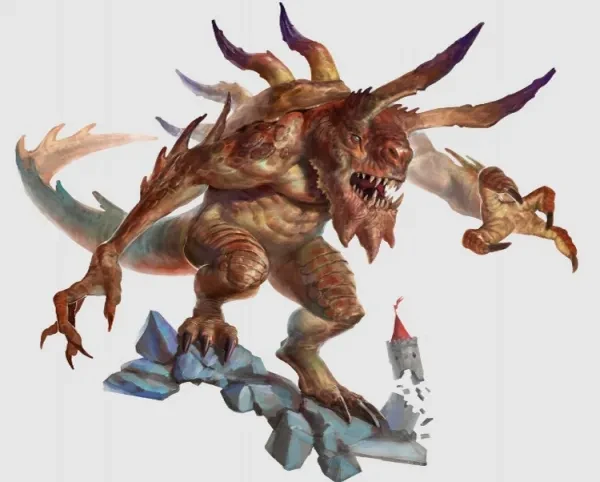
Some of the strongest monsters are the biggest. With long reaches, they’re difficult to dodge and have large amounts of HP. At early levels, they might be easier to hit but even that won’t save players in the later levels. Let’s look at some big monsters you can use on your players.
15. Shanrigol Behemoth

If you look at this picture, you get a good idea of what it looks like for a normal-sized player to face off against a Shanrigol Behemoth. This foul reeking creature feeds on beings that dwell underground like Drow and Driders.
Sometimes, the Shanrigol Behemoth gains the special abilities of whatever creatures it devours. This is why it has web trap (from Driders). A GM can theoretically add other abilities depending on the story they want to tell.
The bigger problem is the necrotic aura. Anything within five feet of the beast takes 9d6 damage. And for mid-level close-range fighters, that’s a lot. And since it’s gargantuan, it can be hard to avoid.
Shanrigol Behemoth stats
- Level 9
- Perception +18; darkvision, tremorsense (imprecise) 30 feet
- Skills Athletics +20, Stealth +16
- AC 27 all-around vision; Fort +21, Ref +18, Will +16
- HP 140 (negative healing); Immunities death effects, disease, paralyzed, poison, unconscious; Resistances slashing 10, piercing 10; Weaknesses positive 10
- Necrotic Decay (divine, necromancy, negative) When the shanrigol behemoth dies, its flesh rots away and sublimates into a foul-smelling gas that fills a 5-foot emanation around the body. This gas deals 9d6 negative damage to creatures in this area as their flesh curdles and rots as well (DC 27 basic Fortitude save).
- Speed 30 feet, climb 20 feet, swim 20 feet
- Melee fleshy slap +21 [+16/+11] (forceful, reach 15 feet), Damage 2d10+11 bludgeoning plus Grab
- Ranged bone shard +18 [+14/+10] (agile, range increment 30 feet, versatile P), Damage 1d12+11 bludgeoning
- Ranged web +18 [+13/+8] (range increment 30 feet), Effect web trap
- Sapping Squeeze Requirements The shanrigol has a creature grabbed; Effect The shanrigol squeezes the life essence from its target, dealing 1d10+11 bludgeoning and 1d6 persistent bleed damage (DC 25 basic Fortitude save). The shanrigol regains temporary Hit Points equal to half the amount of bludgeoning damage a single target takes; these temporary Hit Points last for 1 minute.
- Shred Flesh A shanrigol behemoth's attacks brutally rend its foes. Creatures critically hit by the shanrigol's fleshy slap Strike take an additional 2d6 persistent bleed damage and are enfeebled 1 for as long as they are bleeding.
- Undulating Step The shanrigol separates its flesh from its bones to fit through small spaces. It Strides, ignoring difficult terrain and fitting through tight spaces as though it were a Tiny creature. It can't use any actions other than Undulating Step until it occupies an area large enough for its normal form.
- Web Trap A creature hit by the shanrigol behemoth's web attack is immobilized and stuck to the nearest surface until it can Escape
14. Titan Centipede
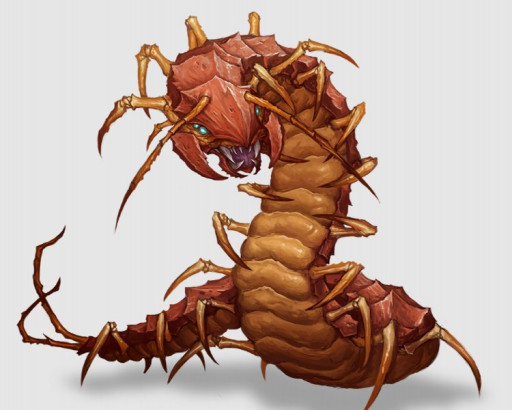
Some bugs stay the size of bugs. Some bugs,for whatever reason, become the size of a building. For those creeped out by centipedes, this is their worse nightmare.
The mandibles are not just for show. They can do considerable damage. The inpaling critical ability inflicts the bleed status. As long as players have this status, they’re flat-footed and easier to hit.
The biggest problem is the venom. It can make players slower. If they manage to envenomate a caster to the point that they are slowed 2, they won’t be able to cast spells.
Titan Centipede stats
- Level 9
- Perception +18; darkvision
- Skills Acrobatics +16, Athletics +21
- Str +8, Dex +1, Con +5, Int -5, Wis +5, Cha -4
- AC 28; Fort +20, Ref +16, Will +18
- HP 155
- Speed 50 feet, climb 50 feet
- Melee mandibles +21 [+16/+11] (reach 20 feet), Damage 2d10+12 piercing plus titan centipede venom
- Melee foot +19 [+14/+9], Damage 2d8+10 bludgeoning
- Impaling Critical When a titan centipede scores a critical hit with its mandibles, the target is painfully pierced with barbed spines and bristles, taking 1d6 persistent bleed damage and becoming flat-footed as long as the bleed damage continues.
- Titan Centipede Venom (poison) Saving Throw DC 28 Fortitude; Maximum Duration 6 rounds; Stage 1 2d6 poison damage and clumsy 2 (1 round); Stage 2 2d8 poison damage, clumsy 2, and slowed 1 (1 round); Stage 3 2d10 poison damage, clumsy 2, and slowed 2 (1 round)
- Trample Huge or smaller, foot, DC 28
- Undulate The titan centipede Strides up to its Speed or Steps. During this movement, it can pass through spaces as narrow as 10 feet without Squeezing.
13. Giant Snapping Turtle
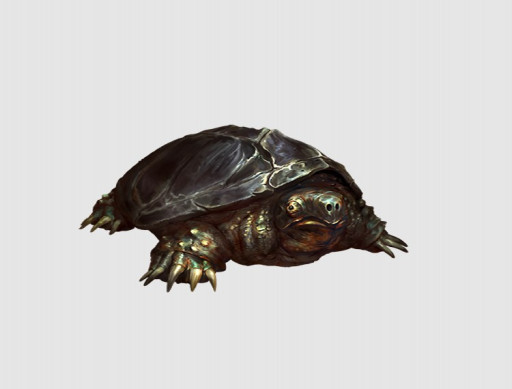
Like most animals, even the Giant Snapping Turtle don’t want to bother humans. Most would prefer to be left alone. However, sometimes they can get in foul moods or corrupted.
If the turtle does attack, he’s got a lot going for him as far as mid-level monsters go. It’s hard to hit. If players face it in water, getting in melee range will be difficult and they may take penalties for being in water depending on their weapon.
It also attacks the boat. The turtle can capsize boats. This can be a dangerous problem because the turtle can swallow players whole.
Giant Snapping Turtle stats:
- Level 9
- Perception +17; low-light vision, scent (imprecise) 30 feet
- Skills Athletics +20
- Str +7, Dex +0, Con +4, Int -4, Wis +4, Cha -2
- Deep Breath The giant snapping turtle can hold its breath for 2 hours.
- AC 28; Fort +19, Ref +15, Will +19
- HP 170
- Speed 20 feet, swim 40 feet
- Melee jaws +22 [+17/+12], Damage 2d12+10 piercing plus Improved Grab
- Capsize (attack, move) The turtle tries to capsize an adjacent aquatic vessel of its size or smaller. The turtle must succeed at a DC 35 Athletics check (reduced by 5 for each size smaller the vessel is than the turtle) or the pilot's Sailing Lore DC, whichever is higher.
- Shell Defense The giant snapping turtle retracts its limbs and head into its shell and ends its turn. This increases its AC to 30, but it can't act except to reemerge, which it can do as a single action.
- Swallow Whole Large, 2d12+7 bludgeoning, Rupture 30
12. Tylosaurus
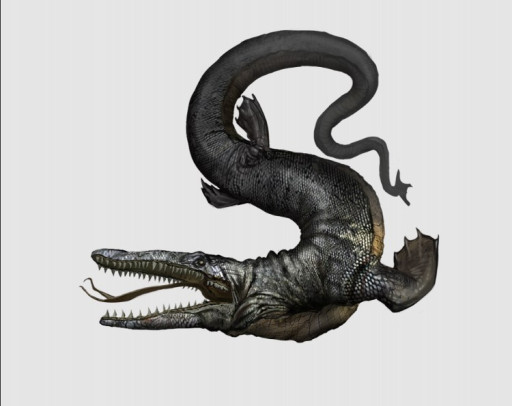
Going deeper into the water, there is the Tylosauus. The Tylosaurus is a purely aquatic monster as it’s more or less helpless on land. But in water, it’s a dangerous dinosaur.
The jaws and tail are strong and do a lot of damage. The vicious stride ability allows it to break through a formation and hit multiple opponents. It can also swallow players whole.
Its aquatic drag ability is its most dangerous ability. If it grabs someone, it can drag them off. Even though it only moves at half speed, it has 3 move actions. And if they’re fighting alongside someone with haste, that’s a problem.
Tylosaurus stats
- Level 8
- Perception +18; low-light vision, scent (imprecise) 30 feet
- Skills Athletics +19, Stealth +19
- Str +7, Dex +5, Con +5, Int -4, Wis +4, Cha -2
- Deep Breath A tylosaurus can hold its breath for 2 hours
- AC 27; Fort +17, Ref +19, Will +14
- HP 137
- Speed 5 feet, swim 80 feet
- Melee jaws +21 [+16/+11], Damage 2d12+10 piercing plus Improved Grab
- Melee tail +19 [+14/+9], Damage 2d6+10 bludgeoning
- Aquatic Drag Requirements The tylosaurus has a creature grabbed; Effect The tylosaurus Swims up to half its Speed, carrying the grabbed creature with it.
- Swallow Whole (attack) Large, 2d6+5 bludgeoning, Rupture 18
- Vicious Strafe The tylosaurus Swims up to its Speed. It can make one jaws Strike and one tail Strike at any points during its movement, each attacking a different target
11. Tyrannosaurus
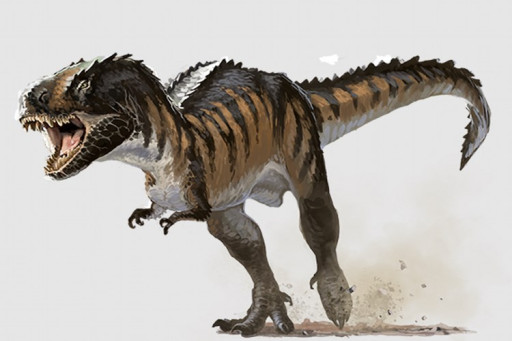
The king of the dinosaurs is alive and well in the world of Pathfinder. He’s exactly as dangerous as you think. He can be made even more dangerous when used as a summoned creature.
The T-Rex can trample anything in its way. It can grab a person and fling them in any direction. This can cut them off from support spells. Or it can swallow them whole.
What makes a T-Rex dangerous is that it can be summoned. Most high-level summoners also have decent support spells. Imagine a T-Rex with haste or damage buffs. It can get dangerous fast. However, they can be fun if a player summons one on their side.
Tyrannosaurus stats:
- Level 10
- Perception +19; low-light vision, scent (imprecise) 30 feet
- Skills Acrobatics +15, Athletics +24
- Str +8, Dex +1, Con +5, Int -4, Wis +3, Cha +0
- AC 29; Fort +21, Ref +15, Will +19
- HP 180
- Speed 40 feet
- Melee jaws +22 [+17/+12] (deadly 1d12, reach 20 feet), Damage 2d12+12 piercing plus Grab
- Melee foot +22 [+17/+12] (reach 15 feet), Damage 2d10+12 bludgeoning
- Fling Requirements A creature is Grabbed in the tyrannosaurus's jaws. Effect The tyrannosaurus flings the creature into the air up to 10 feet up from its mouth and 20ft away. The creature falls 25 feet (assuming the tyrannosaurus flings it as high as it can) and takes falling damage accordingly. If the flung creature lands on another creature, the creature it lands on takes the same amount of bludgeoning damage. The creature being landed upon can attempt a DC 23 basic Reflex save.
- Pin Prey Trigger The tyrannosaurus critically hits a Large or smaller foe with its foot. Effect The creature struck by the foot is knocked prone and the tyrannosaurus uses its foot to hold the creature in place. As long as the tyrannosaurus doesn't move from its position, the pinned creature is Grabbed. A tyrannosaurus gains a +2 circumstance bonus to attack a creature it has pinned in this manner, but it cannot use swallow whole on the target unless it uses its jaws to Grab the victim first.
- Swallow Whole (attack) Medium, 3d6+8 bludgeoning, Rupture 26
- Trample Huge or smaller, foot, DC 29
10. Tyrannosaurus Skeleton
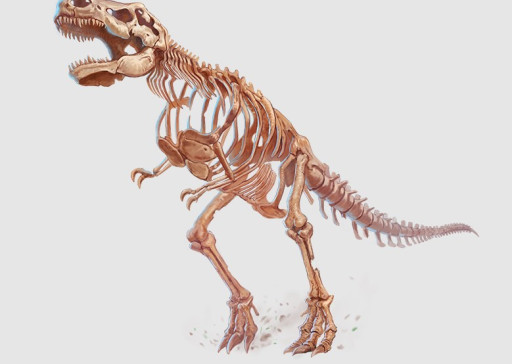
While a living T-Rex is a powerful summoned creature, necromancers also join the fun. They can summon an undead dinosaur. Or magic can make one happen.
The Tyrannosaurus Skeleton has many of the same abilities as its fleshy counterpart. They can bite players. They can use their large size to trample people. The main offensive difference is that they can impale players with their ribs.
Their bigger strength is in their defense. Unlike their living counterparts, they’re immune to most status effects. Mind control spells are useless. They also have resistance to many elements like fire.
- Level 9
- Perception +17; darkvision
- Skills Athletics +22
- Str +7, Dex +0, Con +5, Int -5, Wis +2, Cha +0
- AC 27; Fort +20, Ref +13, Will +17
- HP 140 (negative healing); Immunities death effects, disease, mental, paralyzed, poison, unconscious; Resistances cold 10, electricity 10, fire 10, piercing 10, slashing 10
- Speed 40 feet
- Melee jaws +20 [+15/+10] (deadly d12, reach 20 feet), Damage 2d12+9 piercing plus Grab
- Melee foot +20 [+15/+10] (reach 15 feet), Damage 2d10+9 bludgeoning
- Rib Skewer The tyrannosaurus skeleton bends down, attempting to skewer one adjacent creature on one of its massive ribs. The creature takes 2d10+9 piercing damage (DC 28 basic Reflex save). If the creature fails its save and is Medium or smaller, it's also impaled and stuck to the rib. It moves with the skeleton and takes 2d6 persistent bleed damage until it either Escapes or someone uses Force Open to break the rib (either is DC 28).
- Trample Huge or smaller, foot, DC 28
9. Thunderbird
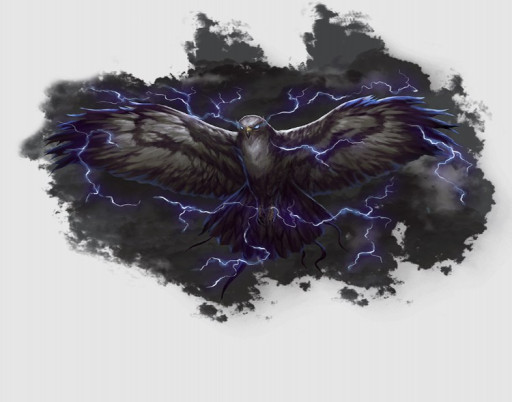
Thunderbirds bring heavy storms with them but they aren’t evil. However, they are impatient with humans. Particularly when they accidentally stumble on their nest.
A Thunderbird can fly high so players will absolutely need a way to inflict ranged damage. Even a fly spell won’t help because the cyclone it creates makes it hard to fly. Forcing it to the ground into melee isn’t easy either. The electrical aura is damaging.
Thunderbirds have powerful lightning attacks. It can strike everyone within thirty feet with a blast of thunder and lightning that does 6d6 sonic damage and 6d6 lighting damage. It can also rain lightning from the sky.
Thunderbird stats:
- Level 11
- Perception +22; darkvision, stormsight
- Languages Auran, Common
- Skills Acrobatics +22, Athletics +23, Intimidation +20, Nature +20
- Str +8, Dex +3, Con +7, Int +3, Wis +5, Cha +3
- Stormsight Wind, precipitation, and clouds don't impair a thunderbird's vision; it ignores the concealed condition from storms, mist, precipitation, and the like.
- AC 31; Fort +24, Ref +20, Will +22
- HP 200; Immunities electricity; Resistances sonic 10
- Storm Aura (air, aura, evocation, primal, water) 100 feet. The thunderbird is surrounded by a cyclone of wind and driving rain. This area is greater difficult terrain for flying creatures, who must successfully Maneuver in Flight (DC 27) or be blown 30 feet away from the thunderbird. Creatures on the ground must succeed at a DC 27 Reflex save to perform any move action and are knocked prone on a critical failure. The driving rain in the storm aura imposes a –2 circumstance penalty on Perception checks and extinguishes smaller flames. A thunderbird can deactivate or activate the storm aura as a free action with the concentrate trait.
- Reactive Shock Trigger A creature enters the thunderbird's reach or uses a move action within their reach; Effect A lightning bolt dancing on the thunderbird's body leaps onto the creature, dealing 8d6 electricity damage (DC 30 basic Reflex save).
- Speed 25 feet, fly 80 feet
- Melee beak +24 [+19/+14], Damage 2d6+12 piercing plus 3d6 electricity
- Melee talon +24 [+20/+16] (agile), Damage 2d8+12 slashing
- Ranged thunderbolt +23 [+18/+13] (range 200 feet), Damage 3d6 electricity and 3d6 sonic plus thunderstrike
- Rituals DC 30; 8th control weather (does not require secondary casters)
- Lightning Blast (evocation, primal) The thunderbird spreads their wings and blasts their foe with thunderous bolts of lightning. Each creature in a 30-foot emanation takes 6d6 electricity damage and 6d6 sonic damage (DC 30 basic Reflex save). The thunderbird can't use Lightning Blast for 1d4 rounds.
- Stormflight A thunderbird can move in wind with ease. They don't treat wind as difficult terrain or need to Maneuver in Flight in high winds.
- Thunderstrike A creature that takes damage from a thunderbird's thunderbolt Strike must succeed at a DC 28 Fortitude save or be knocked prone and deafened for 1 round.
8. Roc
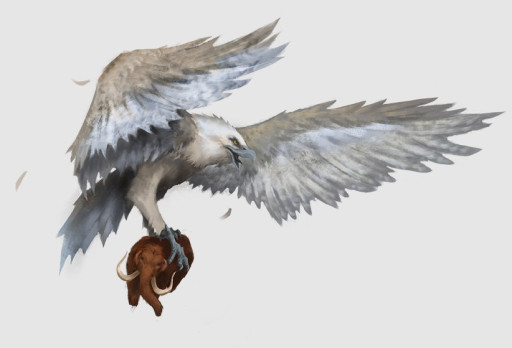
You are in fact seeing a bird carry off a mammoth. That gives you an idea of how big a Roc is. It may be an animal that likely defies the laws of physics but it’s highly predatory. And anything smaller than a Roc is on its menu.
Every part of the Roc’s body is a weapon and it can attack while flying. As you can see from the picture, it can grab things pretty well. If a person manages to escape while in mid-air, they’ll take fall damage.
If a Roc decides to land for melee combat, trying to get in range is painful. A player that gets in its range will be attacked by its wings and has the chance to disrupt a player’s move action. While flying, a Roc can do a flyby attack with its talons.
Roc stats:
- Level 9
- Perception +18; low-light vision
- Skills Acrobatics +15, Athletics +21
- Str +8, Dex +2, Con +5, Int -4, Wis +1, Cha +0
- AC 27; Fort +20, Ref +17, Will +16
- HP 180
- Wing Rebuff Trigger A creature moves from beyond the reach of the roc’s wing to within the reach of the roc’s wing. Effect The roc makes a wing Strike against the triggering creature. If the roc Pushes the creature, it disrupts the triggering move action.
- Speed 20 feet, fly 60 feet
- Melee beak +21 [+16/+11] (reach 15 feet), Damage 2d10+12 piercing
- Melee talon +21 [+17/+13] (agile, reach 15 feet), Damage 2d8+12 slashing plus Improved Grab
- Melee wing +21 [+17/+13] (agile, reach 30 feet), Damage 2d6+10 bludgeoning plus Improved Push 10 feet
- Flying Strafe The roc Flies up to its Speed and makes two talon Strikes at any point during that movement. Each Strike must target a different creature. Each attack takes the normal multiple attack penalty.
- Snack A roc gains a +2 circumstance bonus to hit with its beak Strike if the target is grabbed or restrained in its talon.
7. Chyzaedu
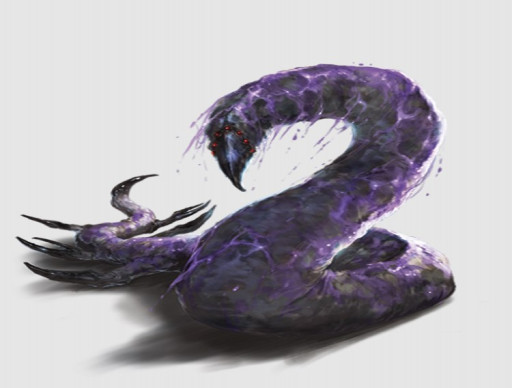
The Dominion of the Black are an alien race that have conquered many worlds and have set their sights on the Pathfinder world. Along the way, they have conquered many other worlds. Some of the conquered people, like the Chyzaedu, have allied with the Dominion.
The Chyzaedu act as priests of the Dominion and have some powerful magic and their priestly vestaments have powerful magic and help them resist damage. They also have powerful healing magic.
The bigger problem is its aura that induces hunger. A critical failure will induce a player to eat things they shouldn’t. A GM who wants to have a battle with a Chyzedu may want to leave poisons on the field
Chyzaedu stats:
- Level 10
- Perception +21; darkvision, tremorsense (imprecise) 60 feet
- Languages Abyssal, Aklo, Common, Draconic, Protean, Undercommon; telepathy 100 feet
- Skills Athletics +21, Diplomacy +17, Intimidation +19, Occultism +22, Religion +21, Survival +19
- Str +7, Dex +3, Con +4, Int +2, Wis +7, Cha +3
- AC 30 (27 without alien vestment); Fort +18, Ref +15, Will +23; +1 status to all saves vs. magic
- HP 135; Resistances acid 10, mental 10, physical 10
- Alien Vestment The chyzaedu wears an eerie, alien layer of shimmering violet mucus that slithers and crawls over its flesh, but is hard as iron to the touch. If a chyzaedu takes bludgeoning damage from a critical hit, its alien vestment is shattered—this reduces its AC to 27 and causes it to lose its resistance to mental and physical damage; it can grow a new alien vestment by concentrating for 1 hour.
- Ecstatic Hunger (aura, emotion, enchantment, incapacitation, mental, occult) 30 feet. A chyzaedu gains sustenance by feeding upon the metabolisms of organic victims. A living creature that ends its turn in the aura must attempt a Will save.
- Critical Success The creature is unaffected and is temporarily immune for 24 hours.
- Success The creature suffers a painful hunger pang, becoming flat-footed for 1 round.
- Failure If possible, the creature spends its first 2 actions on its next turn eating or drinking (or spending actions to procure food or drink from its possessions or the surroundings, if necessary). The creature won't consume anything dangerous, but will eat things it normally has no appetite for.
- Critical Failure As failure, but the creature will eat or drink dangerous consumables, such as poison or rotten food, if other food or drink are not immediately available. The creature must spend its first 2 actions each round consuming for as long as it remains in the chyzaedu's aura plus 1 minute thereafter, but the creature can attempt a new saving throw at the end of its turn each round to end the effect early.
- Speed 25 feet, burrow 20 feet, climb 20 feet
- Melee jaws +21 [+16/+11], Damage 2d12+9 piercing plus Grab
- Melee claw +21 [+17/+13] (agile), Damage 2d8+9 slashing
- Divine Prepared Spells DC 29, attack +21; 5th command, harm (×4), sending; 4th air walk, dimensional anchor, heal; 3rd blindness, chilling darkness, heal; 2nd enhance victuals, ghoulish cravings, silence; 1st command, fear, sanctuary; Cantrips (5th) daze, divine lance, message, read aura, sigil
- Swallow Whole Medium, 3d8+7 bludgeoning, Rupture 26
6. Azure Worm
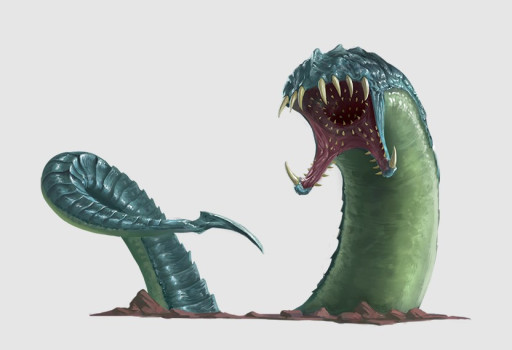
Deep in many caves there are giant worms of varying sorts. While not the smartest creatures, these animals are dangerous. The aquatic variant, the Azure Worm, is one of the worst things you can find in a flooded cave.
The Azure Worm thrives in water, making it a problem for parties without sea combat weapons or capabilities. For parties that are hoping to slow or immobilize it, it won’t work. The Azure worm is immune to basically anything that will alter its speed. The venom from its tail is potent and will inflict the clumsy status.
The most dangerous part of the fight are the jaws. While many gargantuan creatures can swallow, the Azure Worm has fast swallow. Meaning it doesn’t have to wait a turn before trying to swallow someone.
Azure Worm stats:
- Level 15
- Perception +22; darkvision, tremorsense (imprecise) 100 feet
- Skills Athletics +33, Stealth +20 (+25 in water)
- Str +10, Dex -1, Con +8, Int -5, Wis -1, Cha -1
- AC 35; Fort +32, Ref +20, Will +23
- HP 320
- Inexorable The azure worm recovers from the paralyzed, slowed, and stunned conditions at the end of its turn. It’s also immune to penalties to its Speeds and the immobilized condition, and it ignores difficult terrain and greater difficult terrain.
- Shake It Off Frequency once per day; Trigger The azure worm would be affected by a condition or adverse effect (such as baleful polymorph). Effect The azure worm negates the triggering condition or effect. Effects from artifacts, deities, or a similarly powerful source can’t be avoided in this way.
- Speed 40 feet, burrow 40 feet, swim 60 feet
- Melee jaw +31 [+26/+21] (deadly 2d10, reach 15 feet), Damage 3d12+16 piercing plus Improved Grab
- Melee stinger +31 [+27/+23] (agile, poison, reach 15 feet), Damage 4d6+16 piercing plus azure worm venom
- Melee body +29 [+24/+19] (reach 15 feet), Damage 2d8+14 bludgeoning
- Azure Worm Venom (poison) Saving Throw DC 37 Fortitude, Maximum Duration 6 rounds; Stage 1 3d6 poison damage and clumsy 2 (1 round); Stage 2 4d6 poison damage and clumsy 2 (1 round); Stage 3 6d6 poison damage and clumsy 2 (1 round)
- Breach The azure worm Swims up to its swim Speed, then Leaps vertically out of the water up to 30 feet, making a Strike against a creature at the apex of the jump (this lets it attack a creature within 45 feet of the water’s surface). After the Strike, the worm splashes back down. It can use Improved Grab on this Strike and follow it up with Fast Swallow.
- Fast Swallow Trigger The worm Grabs a creature. Effect The worm uses Swallow Whole.
- Swallow Whole Huge, 3d8+10 bludgeoning, Rupture 27
- Thrash The worm makes a Strike once against each creature in its reach. It can Strike up to once with its jaws, up to once with its stinger, and any number of times with its body. Each attack counts toward the worm’s multiple attack penalty, but the multiple attack penalty doesn’t increase until after it makes all the attacks.
5. Neothelid
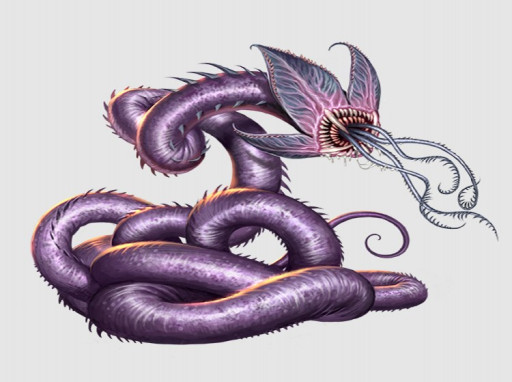
While most worms aren’t very smart, adding a touch of Eldritch magic can increase their mental and magical capabilities. For worms like the Neothelids, this is good. For anyone they encounter, not so much.
The Neothellids have many of the same basic capabilities of the other giant worms but access to magic has given them some unique abilities. They can chase down someone who uses teleportation magic. They also have powerful magic like charm and suggestion. Anyone who fails a will save can have suggestion cast on it instantly.
The most dangerous part is the high-level spells it have. They can summon other aberrations. Phantasmal calamity can be a devastating spell that does 11d6 damage, can trap players in an illusion of a disaster, and stun them. Stunned is the last thing you want to be with an enemy that has the swallow whole ability.
Neothelid stats:
- Level 15
- Perception +29; greater darkvision, thoughtsense 100 feet
- Languages Aklo, Alghollthu, Undercommon; telepathy 100 feet
- Skills Acrobatics +25, Athletics +28, Deception +29, Diplomacy +27, Intimidation +29, Occultism +29
- Str +9, Dex +4, Con +6, Int +8, Wis +6, Cha +8
- Thoughtsense (divination, mental, occult) The neothelid uses its mind as a precise sense at the listed range to notice all non-mindless creatures.
- AC 37; Fort +27, Ref +23, Will +29; +1 status to all saves vs. magic
- HP 345; Immunities acid; Resistances mental 15; Weaknesses cold iron 15
- Dimensional Wormhole (conjuration, occult, teleportation) Trigger A creature the neothelid is aware of uses a teleportation effect; Effect The neothelid creates an extradimensional wormhole at the triggering creature's initial location that persists for up to 1 minute. If the neothelid moves into the wormhole's space, the neothelid teleports to the same destination as the triggering creature.
- Speed 30 feet, fly 50 feet
- Melee jaws +28 [+23/+18] (reach 15 feet), Damage 3d12+13 piercing plus Improved Grab
- Melee rasping tongue +28 [+24/+20] (agile, fatal d10, reach 25 feet), Damage 3d8+13 slashing
- Occult Innate Spells DC 38, attack +30; 8th charm, suggestion, summon entity; 7th phantasmal calamity, teleport; 6th scrying (×3), suggestion (at will); 5th mind probe (at will), telekinetic haul (at will); Cantrips (8th) daze, detect magic, mage hand, telekinetic projectile
- Rituals DC 38; 3rd geas; 2nd inveigle
- Breath Weapon (acid, evocation, occult) The neothelid breathes a spray of acid that deals 16d6 acid damage in a 60-foot cone (DC 38 basic Reflex save). The neothelid can't use Breath Weapon again for 1d4 rounds.
- Instant Suggestion Trigger A creature fails a Will save against a spell or effect created by the neothelid; Effect The neothelid casts a suggestion spell it has available on the creature that failed its Will save.
- Lashing Tongues The neothelid's four tongues lash out in a frenzy at several targets. It makes up to four rasping tongue Strikes, each against a different target. These attacks count toward the neothelid's multiple attack penalty, but the multiple attack penalty doesn't increase until after the neothelid makes all of its attacks.
- Swallow Whole Large, 2d12 bludgeoning plus 2d12 acid, Rupture 27
4. Hekatonheires Titan

The Hekatonheires Titan is the most powerful titan in Pathfinder. This titan sneers in the face of reality. They were originally designed to guard the gates of the Abyss. When they proved too rebellious for the job, they were banished and went to seek their own purpose. More often than not, this purpose leads them to trying to kill Pathfinders.
This creature can make an entrance. When it enters, it shatters barriers between dimensions and casts the storm of vengeance spell. It wields the power of the void and shapes the void into any weapon that has a range of 50 feet and does a lot of damage.
Their Hundred-Handed Whirlwind is devastating. It uses all its weapons at once to attack everyone around it. Even it misses, it still does damage. And anyone who gets caught in a grab, can be banished to another dimension.
Hekatonheires Titan stats:
- Level 25
- Perception +43; darkvision, true seeing
- Languages Abyssal, Aklo, Celestial, Common; telepathy 100 feet
- Skills Acrobatics +42, Athletics +48, Intimidation +45, Occultism +41, Survival +39
- Str +12, Dex +10, Con +12, Int +7, Wis +7, Cha +9
- AC 52 all-around vision; Fort +44, Ref +40, Will +37; +4 status to all saves vs. mental or divine
- HP 500; Immunities death effects, disease
- Impossible Stature (aura, divine, illusion, mental) 100 feet. Titans warp perception and distance around them to seem even larger and more imposing. A creature that enters or begins its turn within the emanation must succeed at a DC 48 Will save or its movement toward the titan is movement over difficult terrain (greater difficult terrain on a critical failure) for 1 round.
- Attack of Opportunity The hekatonkheires gains 99 extra reactions on their turn that they can only use to make Attacks of Opportunity.
- Speed 60 feet; air walk, freedom of movement
- Melee void weapon +45 [+40/+35] (magical, reach 50 feet, versatile P, versatile S), Damage 4d12+18 bludgeoning plus 2d12 force
- Ranged void weapon +43 [+38/+33] (magical, thrown 200 feet, versatile P, versatile S), Damage 4d12+18 bludgeoning plus 2d12 force
- Occult Innate Spells DC 48; 9th bind soul, dimension door, plane shift, weird; Constant (10th) air walk, freedom of movement, true seeing
- Demolish Veil Frequency once per month; Trigger The titan casts plane shift; Effect The titan arrives in a storm of shattered planar barriers. This has the effects of a 10th-level storm of vengeance.
- Hundred-Dimension Grasp The titan reaches between realities to drag foes closer. They attempt an Athletics check and compare the result to the Fortitude DCs of all foes within 120 feet. On a success, a foe is teleported to any square the titan chooses within 120 feet; on a critical success, it's also paralyzed for 1 round. The titan can Grab any foe brought within 30 feet as a free action.
- Hundred-Handed Whirlwind The titan overwhelms opponents with blows both conventional and interplanar. They make one void weapon Strike against each foe within reach. Even on a failed attack (but not a critical failure), the titan deals 24 force damage to the target. This counts as three attacks for the titan's multiple attack penalty.
- Send Beyond Requirements The titan has a creature grabbed; Effect The titan thrusts the creature into a nightmare realm full of lightless hands and eyes. This has the effects of maze (DC 48), but the creature can use Occultism to escape in addition to Perception or Survival. The titan can't use Send Beyond for 1d4 rounds.
- Shape Void The titan molds a weapon from interstellar darkness. This is a +3 major striking weapon in any form. It can't be disarmed and deals an additional 2d12 force damage. If Released, a void weapon vanishes.
3. Lusca
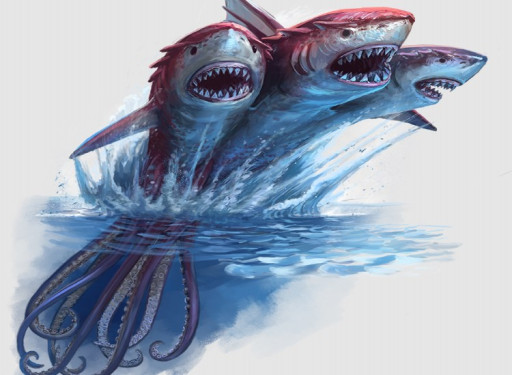
If you’re having a campaign while Discovery Channel is doing their Shark Week programs, why not get into the spirit? Bring out the Lusca. This monster is sure to please some players. Or eat their characters.
Anywhere the Lusca surfaces, massive storm appears. If the characters are fighting on a boat,, they’ll have to manage that while fighting the Lusca. Which is easier said than done since he’ll try to capsize the boat.
The Lusca’s jaws have the rend ability. It also has access to spells like chain lighting and punishing winds. The latter of which will be a problem for any characters that try to get in the air. And the grab ability can be used to try and drown a character.
Lusca stats:
- Level 17
- Perception +31; blood scent, darkvision, scent (imprecise) 100 feet
- Languages Aquan, Common
- Skills Athletics +34, Intimidation +30, Survival +31
- Str +9, Dex +5, Con +9, Int +0, Wis +6, Cha +5
- Blood Scent The lusca can smell blood in the water up to 1 mile away.
- AC 40; Fort +32, Ref +26, Will +29
- HP 320; Immunities electricity
- All-Around Vision
- Storm Bringer (aura, evocation, primal) When the lusca is near the surface for more than 1 hour, clouds appear and deliver a thunderstorm with a 2-mile radius centered on its location. The weather returns to normal 1 hour after the lusca departs.
- Attack of Opportunity The lusca gains 2 extra reactions at the start of each of its turns that it can use only to make an Attack of Opportunity with its jaws. It can't use more than one Attack of Opportunity triggered by the same action.
- Speed 10 feet, swim 50 feet
- Melee jaws +35 [+30/+25] (magical, reach 20 feet), Damage 3d12+17 piercing plus Grab
- Melee tentacle +35 [+30/+25] (magical, reach 40 feet), Damage 3d10+17 bludgeoning plus lusca venom
- Primal Innate Spells DC 38; 9th chain lightning (×3); 8th punishing winds (×3)
- Capsize (attack) The lusca tries to capsize an adjacent aquatic vessel of its size or smaller. It must succeed at an Athletics check with a DC of 35 (reduced by 5 for each size smaller the vessel is than the lusca) or the pilot's Sailing Lore DC, whichever is higher.
- Lusca Venom (poison) Saving Throw Fortitude DC 38; Maximum Duration 6 rounds; Stage 1 4d6 poison damage and clumsy 1 (1 round); Stage 2 6d6 poison damage and clumsy 2 (1 round)
- Ravenous Jaws The lusca makes three jaws Strikes, each against a different target. These attacks count toward the lusca's multiple attack penalty, but the penalty doesn't increase until after the lusca makes all of these attacks. If the lusca subsequently uses the Grab action, it Grabs any number of creatures it hit with Ravenous Jaws.
- Rend jaws
- Swallow Whole (attack) Huge, 4d12+9 bludgeoning, Rupture 38
2. Shadow Worm
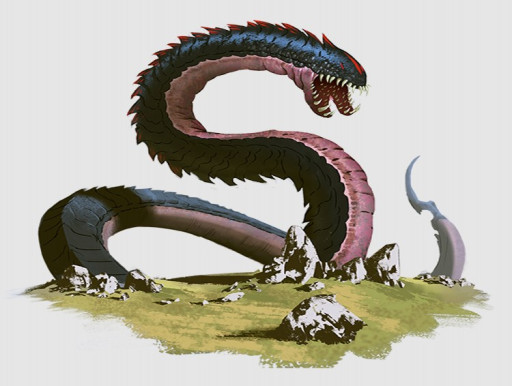
A high-level adventure that takes players to the Shadow Plane will probably involve an encounter with a Shadow Worm. They have many of the abilities of their fellow worms. However, their life on the Shadow Plane gives them unique advantages and disadvantages.
When exposed to light, spells, it takes an additional 20 damage. This makes clerics a powerful asset against Shadow Worms. It also makes their saving throws worse. If a Shadow Worm that has been exposed to light gets a regular success on a saving throw, it turns into a regular failure. A regular failure becomes a critical failure.
In darkness, it becomes a much more troublesome opponent. It regenerates 20 HP each turn. If exposed to a source of magical darkness that it didn’t create, it becomes faster. Its breath weapon can shut down magical lights.
Shadow Worm stats:
- Level 20
- Perception +33; darkvision, tremorsense (imprecise) 100 feet
- Skills Athletics +41, Stealth +32 (+37 in dim light or darkness)
- Str +10, Dex +2, Con +9, Int -4, Wis +0, Cha +0
- AC 45; Fort +36, Ref +32, Will +30
- HP 450 (shadow healing); Resistances cold 20, negative 20; Weaknesses shrink from the light
- Inexorable The shadow worm recovers from the paralyzed, slowed, and stunned conditions at the end of its turn. It's also immune to penalties to its Speeds and the immobilized condition, and it ignores difficult terrain and greater difficult terrain.
- Shadow Healing As long as a shadow worm is in an area of dim light or darkness, it gains fast healing 20. When affected by a magical shadow effect from anything other than itself, a shadow worm becomes quickened 1 for 1 round.
- Shrink from the Light A shadow worm takes an additional 20 damage from any spell or ability with the light trait and uses the outcome one degree worse for saving throws made against a spell or ability with the light trait.
- Speed 40 feet, burrow 40 feet
- Melee jaws +38 [+33/+28] (deadly 2d10, reach 15 feet), Damage 4d10+20 piercing plus Improved Grab
- Melee body +38 [+33/+28] (reach 15 feet), Damage 3d10+20 bludgeoning
- Breath Weapon (cold, evocation, negative, occult, shadow) The shadow worm exhales a blast of clinging shadow, dealing 11d6 cold damage and 10d6 negative damage to creatures in a 60-foot cone (DC 42 basic Reflex save). If the cone passes through an area of magical light or targets a creature affected by magical light, Breath Weapon attempts to counteract the light (+34 counteract modifier). The shadow worm can't use Breath Weapon again for 1d4 rounds.
- Fast Swallow Trigger The shadow worm Grabs a creature; Effect The worm uses Swallow Whole.
- Rock Tunneler A shadow worm can burrow through solid stone at a Speed of 20 feet. It can leave a tunnel if it desires, and it usually does.
- Swallow Whole Huge, 3d10+15 bludgeoning, Rupture 42
- Thrash The worm makes a Strike once against each creature in its reach. It can Strike up to once with its jaws and any number of times with its body. Each attack counts toward the worm's multiple attack penalty, but the multiple attack penalty doesn't increase until after it makes all the attacks.
1, Tarrasque, the Armageddon Engine
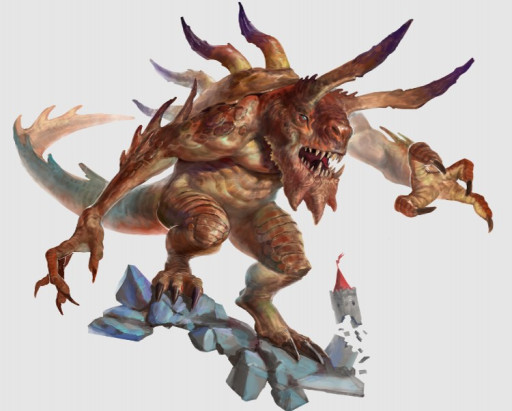
As one of the unholy Spawns of Rovagug, Tarrasque seeks what Rovagug and all his spawn seek. Global destruction. It’s not intelligent and has no capacity for subtlety or manipulation. However, it can level cities on its own so well that it doesn’t need it. Tarrasque the Armageddon Engine is a force of nature and a good choice for a final boss. That or the name of a death metal band.
Its claws jaws, horns, and tail, are lethal weapons. It can fire volleys of spines in a large cone and deal a lot of damage to multiple party members. Like the Azure Worm, it has fast swallow. However, the real problem may be in its defense.
It is immune to a long list of things, including spells that cast in cones, lines, or rays. It isn’t just immune though. It redirects those spells. This means a wizard who was saving his nuclear option spell for the final boss may end up nuking his own party if he attacks without a knowledge check.
Tarrasque stats:
- Level 25
- Perception +48; darkvision, scent (imprecise) 120 feet
- Languages Aklo; can't speak any language
- Skills Acrobatics +47, Athletics +50
- Str +12, Dex +9, Con +12, Int -3, Wis +9, Cha +7
- AC 54; Fort +47, Ref +37, Will +39; +2 status to all saves vs. magic
- HP 540, regeneration 50; Immunities acid, clumsy, disease, drained, enfeebled, mental, paralyzed, persistent damage, petrified, poison, polymorph, stupefied; Resistances fire 25, physical 25
- Carapace Tarrasque is immune to cones, lines, rays, and magic missile spells. These effects bounce harmlessly off its scales.
- Frightful Presence (aura, emotion, fear, mental) 300 feet, DC 39
- Inexorable Tarrasque recovers from the slowed and stunned conditions at the end of its turn. It’s also immune to penalties to its Speeds, and it ignores difficult terrain and greater difficult terrain.
- Reactive Tarrasque gains 3 reactions each round. It can still use only one reaction per trigger.
- Attack of Opportunity
- Reflect Trigger Tarrasque’s carapace deflects an effect. Effect The effect is redirected back at its source
- Speed 50 feet, swim 50 feet
- Melee jaws +45 [+40/+35] (chaotic, evil, magical, reach 20 feet), Damage 5d12+20 piercing plus Improved Grab
- Melee claw +45 [+41/+37] (agile, chaotic, evil, magical, reach 15 feet), Damage 5d10+20 slashing
- Melee tail +45 [+40/+35] (chaotic, evil, magical, reach 30 feet), Damage 4d12+20 bludgeoning
- Melee horn +45 [+40/+35] (chaotic, evil, magical, reach 15 feet), Damage 4d10+20 piercing
- Ranged spine +45 [+40/+35] (brutal, chaotic, evil, magical, range increment 120 feet), Damage 3d10+20 piercing
- Destructive Frenzy Tarrasque makes a jaws Strike, two claw Strikes, two horn Strikes, and one tail Strike in any order.
- Fast Swallow Trigger Tarrasque Grabs a creature with its jaws; Effect Tarrasque uses Swallow Whole.
- Spine Volley Tarrasque flings spines in a 120-foot cone, dealing 3d10+20 piercing damage to each creature in the area (DC 53 basic Reflex save). Tarrasque can’t use Spine Volley again for 1d4 rounds.
- Swallow Whole (attack) Huge, 10d6+12 bludgeoning plus 10d6 acid, Rupture 50
- Trample Huge or smaller, claw, DC 49. When Tarrasque Tramples, it can Stride up to triple its Speed.
